
a web page by Don Roberson |
RAILS & ALLIES Rallidae |
||||
|
||||
|
||||
Ridgway's Rail was split in 2014 from the eastern Clapper Rail Rallus crepitans. Traditionally, the continental "Clapper Rail," as it was known, and the King Rail of the Gulf Coast (right, with half-grown youngster), were considered to be the "large rails" of North America. Now they are split five ways, based primarily on Maley and Brumfield (2013): Clapper became Clapper, Ridgway's, and Mangrove Rail R. longirostris (of the Caribbean), while Aztec Rail R. tenuirostris (of Mexico) was split from King Rail. |
||||
Evolutionarily, the ancestors of today rails arose in the Eocene, and diverged from flufftails (genus Sarothrura) and a couple Old World largish rails (genus Canirallus) about 60 million years ago; Garcia-R. et al. (2014). Major world lists, including eBird/Clements, now consider the Sarothruridae a separate family, which also includes the three species Canirallus (one in Africa, two on Madagascar). The phylogeny constructed from molecular evidence (Garcia-R., et al. 2014) would then divide the remaining Rallidae into three major clades (considered subfamilies by some) and a half-dozen tribes.
|
||||
The next subfamily has two clades: a set of mostly Neotropical rails, including 7 species of Aramides wood-rails, and the worldwide set of coots, moorhens, and Porzana rails. The New World wood-rails include large rails that live in tidal mangrove swamps or in forest. Gray-necked Wood-Rail (right) is one of those. Although quite large, these rails walk in and out of the mangroves or forests noiselessly and can be difficult to observe. This one was enticed briefly into the open by a scattering of rice at the forest's edge in Costa Rica. |
||||
|
||||
Rails in the genus Porzana are mid-sized and prefer freshwater marshes or ponds. They have a global distribution but appear generally similar to each other. These are Australian Crake (above left) and Sora (above right), the latter widespread in North America. Spotted Crake Porzana porzana of western Eurasia is also similar; both the Spotted Crake and Sora are highly migratory. Some Spotted Crakes winter well south of the equator in Africa.
Extinction in rails, particularly on islands, has been perhaps more dire than in any other family of bird. At least 21 species have become extinct in historical times, representing about 15% of the Rallidae species on earth in the last four hundred years. |
||||
At the other end of the spectrum in this subfamily, the coots — at least those not on islands! — have done very well indeed. [Coots on islands are a different story and, like many rails, have tenuous populations. The Hawaiian Coot Fulica alai is on the Endangered species list.]
In North America, I helped debunk claims of Caribbean Coot Fulica caribaea in Florida, which were based on a specimen and a few sight records of 'white-shielded' coots there in winter that lacked the red knob at the top of the shield. Both the late great Luis Baptista and I had separately discovered 'white-shielded' coots in California in winter, and we learned of others elsewhere across the U.S. We borrowed and measured the Florida specimen (its measurements were consistent with American Coot) and published a paper (Roberson & Baptista 1988) that compelled the AOU to removed "Caribbean Coot" from the North American list. Basically, we showed that some small percentage of American Coots with excess testosterone develop all-white shields, like this one (below right) in Los Angeles County, California. They do so on the breeding grounds in the north, and then migrate to California and Florida (and elsewhere) in winter. |
||||
|
||||
A young Purple Gallinule (below) is quite different in plumage than the multi-colored adult. One of these — this one (below) is from the Brazilian Pantanal — can be difficult to spot as it picks berries among the undergrowth at the edge of a swamp. Notice that it acts very 'rail-like' in cocking its tail up, showing the white undertail coverts. Young gallinules remind me of rallid vagrancy, which can be very remarkable. A brown immature Purple Gallinule showed up at a local pond in a busy east San Francisco Bay city in the 1980s. And this list of vagrant rails from the Neotropics that has reached the United States is remarkable, including Corn Crake Crex crex, Rufous-necked Wood-Rail Aramides axillaris, Paint-billed Crake Neocrex erythrops, Spotted Rail Pardirallus maculatus, and Azure Gallinule Porphyrio flavirostris. The Wood-Rail was briefly chaseable in New Mexico (until its favored pool dried up) but the rest remain near-mythical entries on the AOU checklist. |
||||
 |
||||
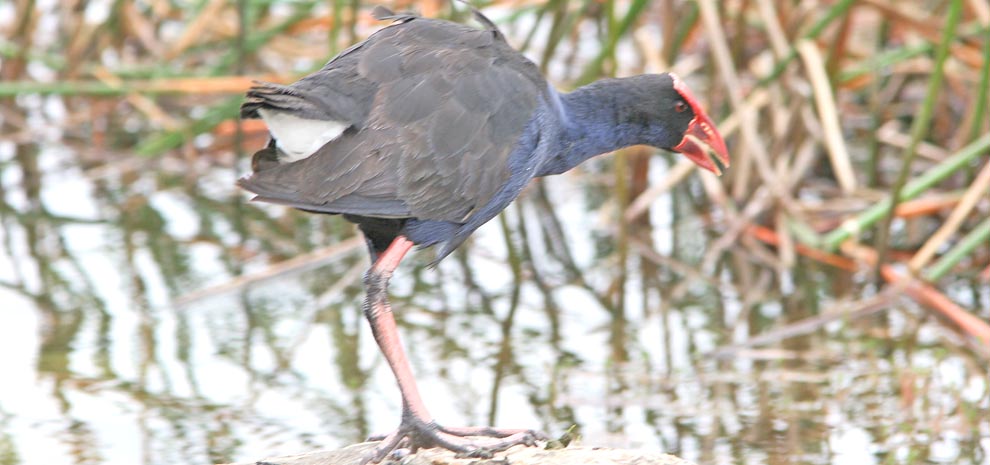 |
||||
|
||||
|
||||
Takahe specialized in alpine grasslands but it is thought that post-glacial warming had them on the decline when Polynesian settlers arrived about 1000 years ago, bringing dogs, rats, and hunting. All Takahes were thought extinct until a tiny population of South Island Takahe was rediscovered in 1948. A few are still present in the Murchison Mountains of South Island, but the species survives primarily because it has been successfully translocated to small predator-free offshore islands, like Tiritiri Matangi (Mills et al. 1984, Trewick & Worthy 2001). Both species of Takahe are more closely related to Australasian Swamphen than the Australasian Swamphen is to other swamphens. Because Takahes are genetically 'embedded' in the swamphen complex, the only way to properly maintain species status of the undoubtedly distinct Takahes is to split the swamphens into multiple species. García-R & Trewick (2015) split them into 6 species, and Takahe is now the 7th extant species of Porphyrio. |
||||
|
||||
This is not so much the case with Gray-breasted Crake (far right), a widespread species in the Neotropics. We saw this one only because it walked into our cabin at Rio Cristalino and ended up wandering around in the bathroom, where we gently caught it (and took this shot before releasing in a nearby marsh). I would be remiss to omit two of the most difficult rails to see: Yellow Rail Coturnicops noveboracensis of North America and the similar Swinhoe's Rail C. exquisitus of northeast Asia. Both are migratory, breeding in wet meadows and shallow grassy swamps and migrating to dense cover in coastal marshes in winter. On the breeding grounds they are night birds; the tic-tic-tic of Yellow Rail (like tapping two coins together rhythmically) is not hard to hear but most efforts to see them at night are failures. In contrast, the wonderfully-named Inaccessible Island Rail Atlantisia rogersi is not the least bit migratory — it is the world's smallest flightless rail. It is said to be abundant on its one island in the Tristan da Cunha group of the South Atlantic (Taylor 1996) . . . . but given the name of the island, how did any one figure that out? |
||||
Molecular evidence showed this was not the accurate. Now, is grouped with the swamphen set, and seems to be sister to the New Guinea Flightless Rail Megacrex inepta (Garcia-R. & Trewick 2015). Yet Nkulengu Rail is a very strange and elusive creature. During the day it forages on the forest floor in vast stretches of jungle, and at night has enough flight to reach night roosts up in the canopy (left, a photo at a night roost by David Hoddinott). At times, in the dark of night or in pre-dawn gloom, pairs gives an amazingly loud and antiphonal duet — ho-KAW-ho-KAW, ho-KAW-ho-KAW — with deep voices that are human-like — a spine-tingling nighttime rhythmic performance that must be heard to be believed (as of today, a recording of the duet is not yet on xeno-canto, although single call-notes are there). I had the great experience of hearing it several times during our camping in Ankasa NP, Ghana, on a Rockjumper tour. James Ntakor, of Ashanti Tours who was leading a private Rockjumper Tour at the same location and time, tracked a pair to their night roost and the word got back to us — hastily donning shoes we followed with flashlights and had a view very similar to Hoddinott's photo from the prior year (above; courtesy of Rockjumper Tours). It might be my most memorable encounter with a rail — but there have been many moments from which to chose. |
||||
Photos: The Ridgway's Rail Rallus obsoletus
was photographed during a very high tide at the Palo Alto Baylands
Reserve on San Francisco Bay, California, on 2 Feb 1979. The adult and
young King Rail R. elegans was at Anahuac NWR, Texas, on 28 Apr 2014. The Buff-banded Rail Gallirallus philippensis was on Heron I., Great Barrier Reef, Australia, in Sep 1983. The Gray-necked Wood-Rail Aramides cajaneus was at Rio Tigre, Costa Rica, on 26 Dec 2007. The Australian Rail Porzana fluminea was at Deniliquin, NSW, Australia, on 1 Jan 1998. The Sora P. carolina was at Crespi Pond, Pacific Grove, CA, on 27 Sep 2005. The now-extinct Laysan Rail P. palmeri was photographed in 1913 by Alfred M. Bailey (photo now in the public domain). The flop-footed Eurasian Coot Fulica atra was at King James Park, London, U.K., on 10 July 1969. The adult feeding a young American Coot F. americana
was at Roberts L., Seaside, CA on 6 July 1999, and the one with a white
shield was at Arcadia, Los Angeles Co., on 27 Dec 1983. Greg W. Lasley
took the beautiful shot of Purple Gallinule Porphyrio martinicus at Anahuac NWR, Texas, on 7 Apr 1999; my photo of an immature was in the Brazilian Pantanal on 19 July 2010. The Australasian Swamphen Porphyrio melanotus was at Waro L., North Island, New Zealand, on 16 Nov 2009. The Black-backed Swamphen Porphyrio indicus was at Bueng Boraphet, central Thailand, on 29 Dec 2012. The Gray-headed Swamphen Porphyrio poliocephalus was at Bharatpur, India, in March 2001. Dale Zimmerman shot the African Swamphen Porphyrio madagascariensis at Lake Naivasha, Kenya, in April 1968. Blake Matheson took the Philippine Swamphen Porphyrio pulverulentus at Bislig, Mindanao, Philippines, in Jan 2006. The banded South Island Takahe Porphyrio hochstettere was on Tiritiri Matangi I., New Zealand, on Dec 1997. The adult with young White-browed Crake Poliolimnas cinereus was at Bueng Boraphet, Thailand, on 29 Dec 2012. John Luther snapped the Black Rail Laterallus jamaicensis at the Palo Alto Baylands on 22 Nov 1972. Dale Zimmerman photographed the engaging Black Crake Limnocorax flavirostra at Lake Naivasha, Kenya, in Aug 1979. The captured Gray-breasted Crake Limnocrex exilis was at Rio Cristalino, central Brazil, in Aug 1999. David Hoddinott photographed the night-roosting Nkulengu Rail Himantornis haematopus at Ankasa, Ghana, in Dec 2013 (where I had a similar experience a year later; photo courtesy of Rockjumper Tours). Family Book: Rating:
Literature cited:
|
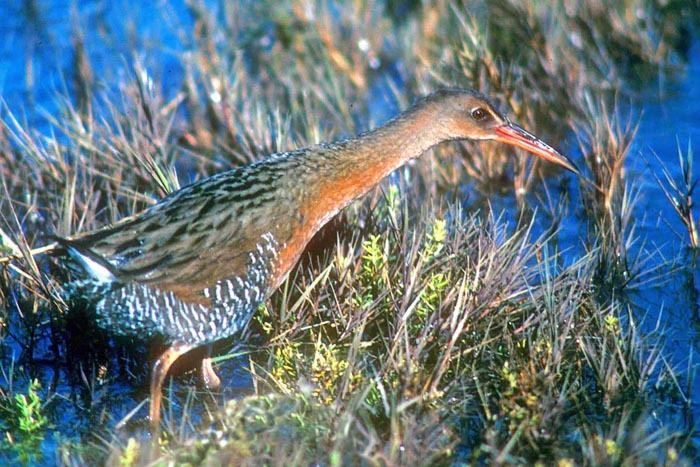 The
term "thin as a rail" is a comparison to members of the Rallidae. Many
are adapted to living in wetlands, slipping silently between reeds, and
making them almost invisible to observers. Ridgway's Rail
(left) is among them. Almost impossible to view in tidal wetlands of
the western U.S., it can be seen in the open, like this, from
boardwalks during the highest tides of the year. S. Dillon Ripley, in
his 1977 monograph on rails, noted that rails, which are constantly
walking without stopping to look around when inside cover, seem oddly
nonchalant when out in the open. "In other words, if a rail chooses
to come out into the open it may behave as if is was still in cover. .
. This is not to say that if disturbed they cannot melt into the reeds
like a wraith. But they react to alarm without calling, and without
flying, simply walking away."
The
term "thin as a rail" is a comparison to members of the Rallidae. Many
are adapted to living in wetlands, slipping silently between reeds, and
making them almost invisible to observers. Ridgway's Rail
(left) is among them. Almost impossible to view in tidal wetlands of
the western U.S., it can be seen in the open, like this, from
boardwalks during the highest tides of the year. S. Dillon Ripley, in
his 1977 monograph on rails, noted that rails, which are constantly
walking without stopping to look around when inside cover, seem oddly
nonchalant when out in the open. "In other words, if a rail chooses
to come out into the open it may behave as if is was still in cover. .
. This is not to say that if disturbed they cannot melt into the reeds
like a wraith. But they react to alarm without calling, and without
flying, simply walking away."  Ripley
also noted that as they walk, most rails — like the Ridgway's above —
flick their short tail upwards, showing white undertail coverts. "I
believe," he wrote, "that the tail jerk, like the head glide of a
walking pigeon, accompanied by a very short momentary pause in the
forward gait, gives the walking rail a pulsed and instantaneous clear
view."
Ripley
also noted that as they walk, most rails — like the Ridgway's above —
flick their short tail upwards, showing white undertail coverts. "I
believe," he wrote, "that the tail jerk, like the head glide of a
walking pigeon, accompanied by a very short momentary pause in the
forward gait, gives the walking rail a pulsed and instantaneous clear
view." 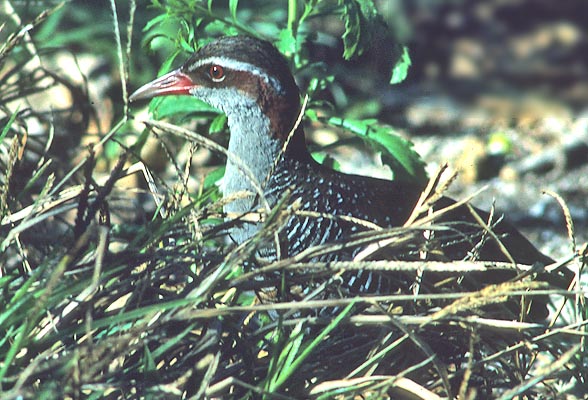 The Rallus rails (above) are among that first clade, but the largest genera in the set is 15 or so species of genus Gallirallus
of Australasia and the western Pacific Islands. The molecular evidence
presented by Garcia-R. et al. (2014) support the concept that Buff-banded Rail
(left), secretive on the Australian continent, is a "super-tramp"
species with an impressive ability to disperse across miles of open
ocean. Today it has populations in New Guinea, Sulawesi, New Zealand,
and out to Fiji and Samoa, but ancient dispersals by its ancestors went
even farther. Some of these evolved into flightless endemics on
far-flung Pacific Islands, including such species as Lord Howe Rail G. sylvestris and Okinawa Rail G. okinawae.
Over a half-dozen of those ancestral island endemics have since become
extinct, largely due to man and his commensal dogs and rats. Guam Rail G. owsteni
nearly went extinct in the 1980s with the accidental introduction of
Brown Tree Snake from New Guinea into Guam. A handful were saved from
that holocaust through captive breeding, and now are being introduced
to snake-free nearby islands (Rota and the islet of Cocos). I was very
fortunate to see one in the wild on Guam in 1978, before they plunged
toward the abyss.
The Rallus rails (above) are among that first clade, but the largest genera in the set is 15 or so species of genus Gallirallus
of Australasia and the western Pacific Islands. The molecular evidence
presented by Garcia-R. et al. (2014) support the concept that Buff-banded Rail
(left), secretive on the Australian continent, is a "super-tramp"
species with an impressive ability to disperse across miles of open
ocean. Today it has populations in New Guinea, Sulawesi, New Zealand,
and out to Fiji and Samoa, but ancient dispersals by its ancestors went
even farther. Some of these evolved into flightless endemics on
far-flung Pacific Islands, including such species as Lord Howe Rail G. sylvestris and Okinawa Rail G. okinawae.
Over a half-dozen of those ancestral island endemics have since become
extinct, largely due to man and his commensal dogs and rats. Guam Rail G. owsteni
nearly went extinct in the 1980s with the accidental introduction of
Brown Tree Snake from New Guinea into Guam. A handful were saved from
that holocaust through captive breeding, and now are being introduced
to snake-free nearby islands (Rota and the islet of Cocos). I was very
fortunate to see one in the wild on Guam in 1978, before they plunged
toward the abyss.  Two rails with really great English names are in this first subfamily: Snoring Rail Aramidopsis (may become Lewinia) plateni — from Sulawesi, and obviously named for its call — and from nearby Halmahera in eastern Indonesia: the Invisible Rail Habroptila (Gallirallus?) wallacii. It has been heard by birders but only an extremely lucky few have ever actually seen the Invisible Rail!
Two rails with really great English names are in this first subfamily: Snoring Rail Aramidopsis (may become Lewinia) plateni — from Sulawesi, and obviously named for its call — and from nearby Halmahera in eastern Indonesia: the Invisible Rail Habroptila (Gallirallus?) wallacii. It has been heard by birders but only an extremely lucky few have ever actually seen the Invisible Rail!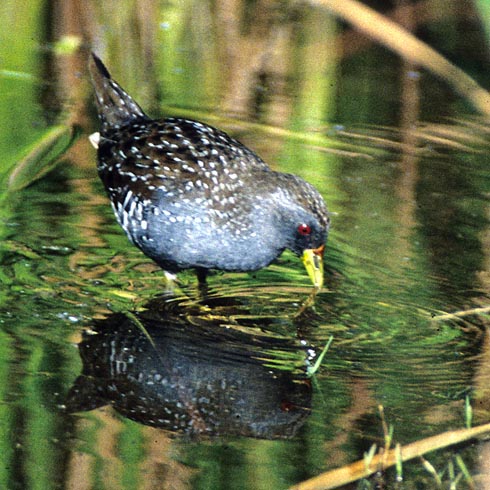
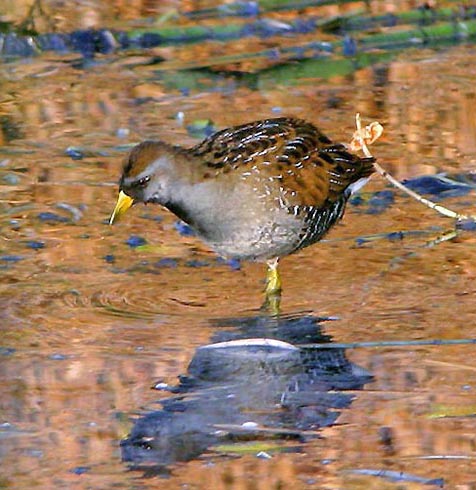
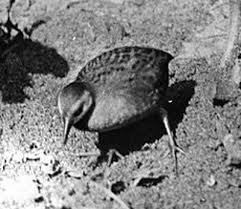 Ancestors of today's Porzana
rails were such long-distance fliers that they colonized islands in the
middle of the Pacific Ocean, and evolved there into flightless island
endemics. These included Hawaiian Rail P. sandwichensis (extinct by 1844) and Laysan Rail,
discovered later in the 19th century (photo, right, an amazing
historical photo by A.M. Bailey in 1913). There are 53 species, either
living today or which became extinct since 1600, which are known only
from islands. Of these, 32 species (nearby 60%) became flightless or
nearly so (Taylor 1996). On the small island of Laysan, the
introductions of rabbits drove the rail to extinction as they had no
means to disperse. The fertile rabbits, in a land without predators,
soon produced so many bunnies that they ate the entire vegetation cover
on the island. Laysan Rail is believed to have become extinct there
during 1923.
Ancestors of today's Porzana
rails were such long-distance fliers that they colonized islands in the
middle of the Pacific Ocean, and evolved there into flightless island
endemics. These included Hawaiian Rail P. sandwichensis (extinct by 1844) and Laysan Rail,
discovered later in the 19th century (photo, right, an amazing
historical photo by A.M. Bailey in 1913). There are 53 species, either
living today or which became extinct since 1600, which are known only
from islands. Of these, 32 species (nearby 60%) became flightless or
nearly so (Taylor 1996). On the small island of Laysan, the
introductions of rabbits drove the rail to extinction as they had no
means to disperse. The fertile rabbits, in a land without predators,
soon produced so many bunnies that they ate the entire vegetation cover
on the island. Laysan Rail is believed to have become extinct there
during 1923.  Eurasian Coot (left) is an abundant migratory rail in Eurasia, as is American Coot in North America (below left, feeding a nearly full-grown fledgling). Coots, and their close relatives Common Moorhen Gallinula chloropus in the Old World and Common Gallinule G. galeata
in the New World, have evolved wonderfully adapted lobed toes, which
aid immensely in swimming. These are not shy rails like the rest of the
family. They easily stride across a public park (here, left, King James
Park in London) and allow 17-year-old tourists (me, in this case) to
snap its photo at close range (it is possible this was my first bird
photo).
Eurasian Coot (left) is an abundant migratory rail in Eurasia, as is American Coot in North America (below left, feeding a nearly full-grown fledgling). Coots, and their close relatives Common Moorhen Gallinula chloropus in the Old World and Common Gallinule G. galeata
in the New World, have evolved wonderfully adapted lobed toes, which
aid immensely in swimming. These are not shy rails like the rest of the
family. They easily stride across a public park (here, left, King James
Park in London) and allow 17-year-old tourists (me, in this case) to
snap its photo at close range (it is possible this was my first bird
photo).
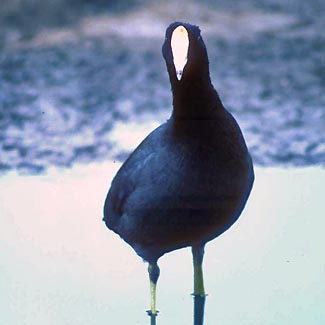
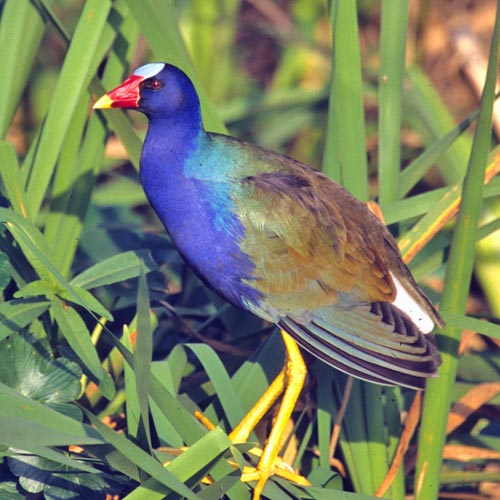 The
final clade (subfamily) of the Rallidae are composed of the purple
gallinules, swamphens, bush-hens, and assorted tropical crakes.
Somewhat surprisingly, the dazzling Purple Gallinule
(right, in a lovely Greg Lasley photo), ranging from the southeastern
U.S. into Argentina, is not closely related to Common Gallinule or
coots. It is more closely related to Old World swamphens (more on
swamphens below).
The
final clade (subfamily) of the Rallidae are composed of the purple
gallinules, swamphens, bush-hens, and assorted tropical crakes.
Somewhat surprisingly, the dazzling Purple Gallinule
(right, in a lovely Greg Lasley photo), ranging from the southeastern
U.S. into Argentina, is not closely related to Common Gallinule or
coots. It is more closely related to Old World swamphens (more on
swamphens below). 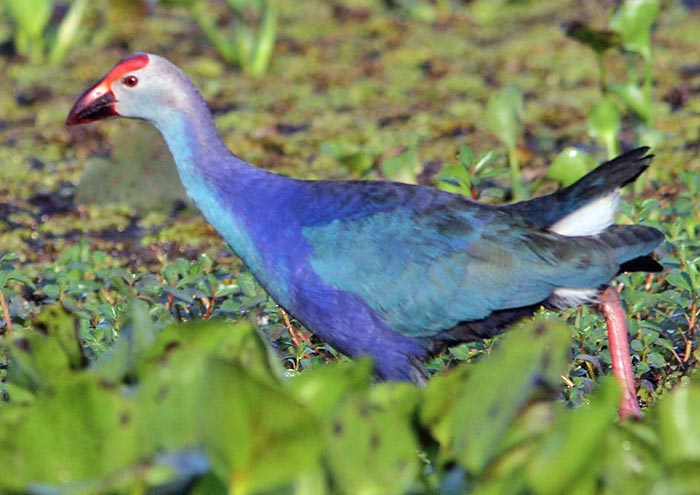 In
the Old World, the large and widespread marshbird known as "Purple
Swamphen" was just split into 6 species (García-R & Trewick
2015). There are substantial plumage differences among them but the
split is based primarily on genetic evidence. In what is now Australasian Swamphen
(above, from Moluccas and New Guinea to Australia and New Zealand) the
face, back and wings are blackish and the bill is red, while in Black-backed Swamphen (right, in southeast Asia), the face is pale, the bill has much dark, and the wings have both black and azure. The Gray-headed Swamphen
(below left, of the Indian subcontinent) has a gray head and purple
back, but where its range approaches Black-backed, some integrations
have been reported (Ripley 1977, which might apply to the bird at
right, from c. Thailand?). The African Swamphen (below, top right, in a Dale Zimmerman shot) is richly dark purple and the endemic Philippine Swamphen (below, lower right, in a Blake Matheson photo) is deep pale purple.
In
the Old World, the large and widespread marshbird known as "Purple
Swamphen" was just split into 6 species (García-R & Trewick
2015). There are substantial plumage differences among them but the
split is based primarily on genetic evidence. In what is now Australasian Swamphen
(above, from Moluccas and New Guinea to Australia and New Zealand) the
face, back and wings are blackish and the bill is red, while in Black-backed Swamphen (right, in southeast Asia), the face is pale, the bill has much dark, and the wings have both black and azure. The Gray-headed Swamphen
(below left, of the Indian subcontinent) has a gray head and purple
back, but where its range approaches Black-backed, some integrations
have been reported (Ripley 1977, which might apply to the bird at
right, from c. Thailand?). The African Swamphen (below, top right, in a Dale Zimmerman shot) is richly dark purple and the endemic Philippine Swamphen (below, lower right, in a Blake Matheson photo) is deep pale purple. 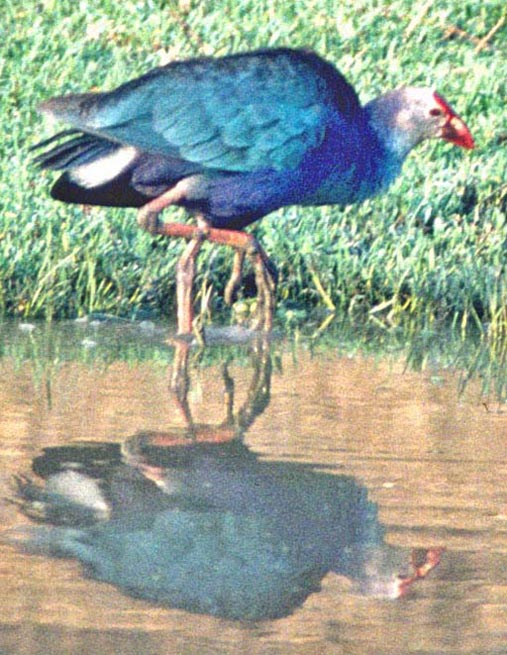

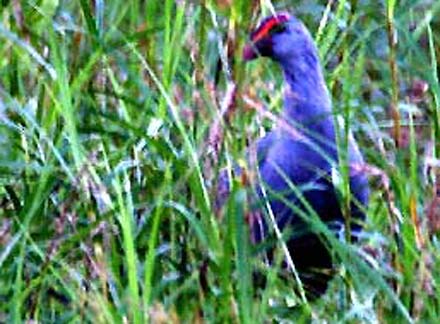
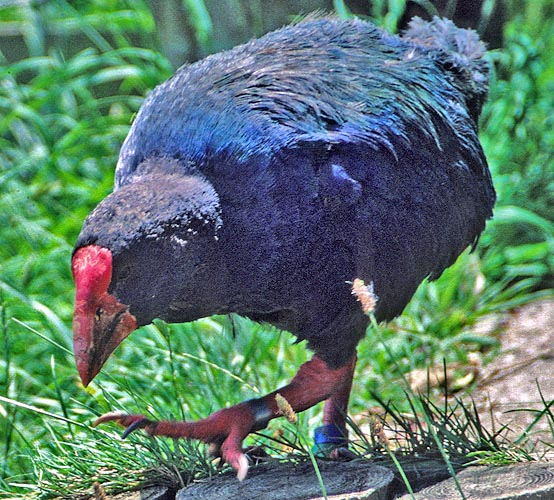 A
big reason for the split is the existence the Takahe of New Zealand,
itself now split into the now-extinct North Island Takahe Porphyrio mantelli
and South Island Takahe. If you thought the purple swamphens were big,
lumbering birds, the huge flightless Takahe puts them to shame — it is
a primordial monster! Just look at those tree-trunk thick legs and
compare them to any swamphen. The one (right) is a South Island Takahe, reintroduced to various offshore islets (here, Tiritiri Matangi)
A
big reason for the split is the existence the Takahe of New Zealand,
itself now split into the now-extinct North Island Takahe Porphyrio mantelli
and South Island Takahe. If you thought the purple swamphens were big,
lumbering birds, the huge flightless Takahe puts them to shame — it is
a primordial monster! Just look at those tree-trunk thick legs and
compare them to any swamphen. The one (right) is a South Island Takahe, reintroduced to various offshore islets (here, Tiritiri Matangi)  Allied with swamphens are bush-hens (genus Amaurornis), Watercock Gallicrex cinerea, and White-browed Crake
(left, an adult with two downy chicks). Downy black chicks are normal
among Rallidae and have sometimes been confused with all-black rails,
like the enigmatic Black Rail of North America
(below, a John Luther photo). Black Rail is nearly impossible to see
except at the highest winter tides, and even then, one usually gets the
barest glimpse.
Allied with swamphens are bush-hens (genus Amaurornis), Watercock Gallicrex cinerea, and White-browed Crake
(left, an adult with two downy chicks). Downy black chicks are normal
among Rallidae and have sometimes been confused with all-black rails,
like the enigmatic Black Rail of North America
(below, a John Luther photo). Black Rail is nearly impossible to see
except at the highest winter tides, and even then, one usually gets the
barest glimpse. 
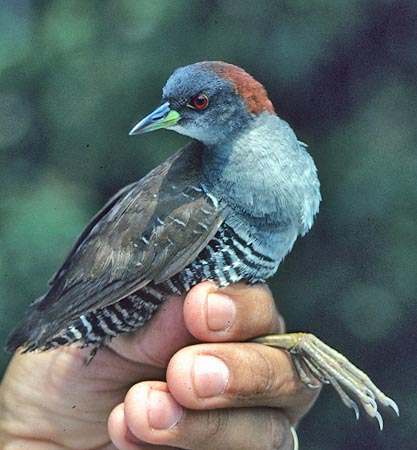
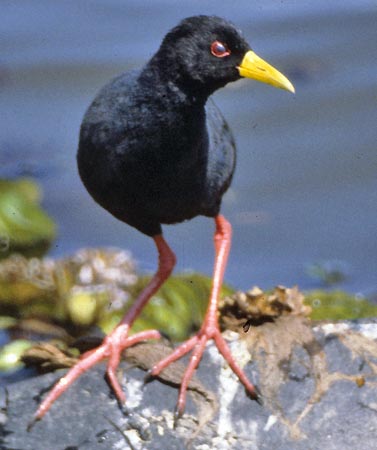 There
are a number of small crakes in the Old World and Neotropics. Most of
these are very elusive and are more often heard than seen, but an
exception is Black Crake (near right in a fine Dale
Zimmerman photo). Widespread in sub-Saharan Africa, it uses its long
toes to walk on floating plants around the edges of ponds and lakes,
and manages to show itself surprisingly often.
There
are a number of small crakes in the Old World and Neotropics. Most of
these are very elusive and are more often heard than seen, but an
exception is Black Crake (near right in a fine Dale
Zimmerman photo). Widespread in sub-Saharan Africa, it uses its long
toes to walk on floating plants around the edges of ponds and lakes,
and manages to show itself surprisingly often. 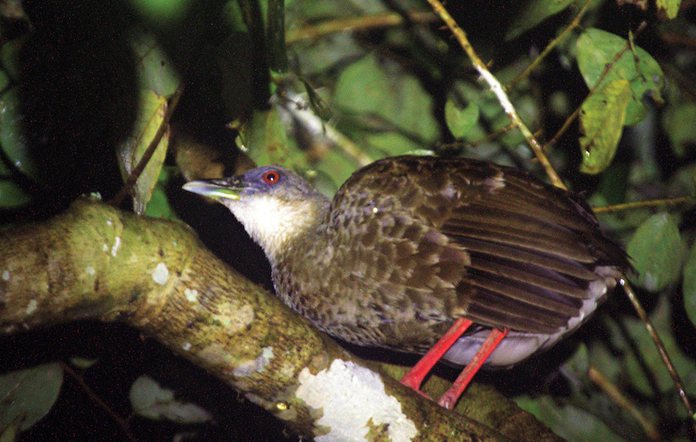 Before
its DNA was analyzed, the Nkulengu Rail of central and west Africa was
thought to be perhaps the most "primitive" of all rails. It was
considered an early evolutionary offshoot of ancient rails, and Olson
(1973) placed it in its own subfamily, completely separating it from
other rails [he only that two subfamilies].
Before
its DNA was analyzed, the Nkulengu Rail of central and west Africa was
thought to be perhaps the most "primitive" of all rails. It was
considered an early evolutionary offshoot of ancient rails, and Olson
(1973) placed it in its own subfamily, completely separating it from
other rails [he only that two subfamilies]. 